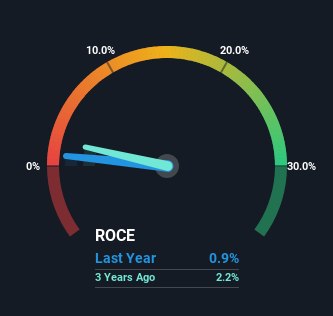- United Kingdom
- /
- Construction
- /
- LSE:SMJ
J. Smart (Contractors) (LON:SMJ) Will Be Hoping To Turn Its Returns On Capital Around
Did you know there are some financial metrics that can provide clues of a potential multi-bagger? Typically, we'll want to notice a trend of growing return on capital employed (ROCE) and alongside that, an expanding base of capital employed. This shows us that it's a compounding machine, able to continually reinvest its earnings back into the business and generate higher returns. In light of that, when we looked at J. Smart (Contractors) (LON:SMJ) and its ROCE trend, we weren't exactly thrilled.
Return On Capital Employed (ROCE): What Is It?
If you haven't worked with ROCE before, it measures the 'return' (pre-tax profit) a company generates from capital employed in its business. The formula for this calculation on J. Smart (Contractors) is:
Return on Capital Employed = Earnings Before Interest and Tax (EBIT) ÷ (Total Assets - Current Liabilities)
0.0095 = UK£1.3m ÷ (UK£149m - UK£17m) (Based on the trailing twelve months to January 2023).
So, J. Smart (Contractors) has an ROCE of 0.9%. Ultimately, that's a low return and it under-performs the Construction industry average of 12%.
View our latest analysis for J. Smart (Contractors)

Historical performance is a great place to start when researching a stock so above you can see the gauge for J. Smart (Contractors)'s ROCE against it's prior returns. If you'd like to look at how J. Smart (Contractors) has performed in the past in other metrics, you can view this free graph of past earnings, revenue and cash flow.
What The Trend Of ROCE Can Tell Us
On the surface, the trend of ROCE at J. Smart (Contractors) doesn't inspire confidence. Over the last five years, returns on capital have decreased to 0.9% from 3.1% five years ago. Given the business is employing more capital while revenue has slipped, this is a bit concerning. This could mean that the business is losing its competitive advantage or market share, because while more money is being put into ventures, it's actually producing a lower return - "less bang for their buck" per se.
In Conclusion...
In summary, we're somewhat concerned by J. Smart (Contractors)'s diminishing returns on increasing amounts of capital. But investors must be expecting an improvement of sorts because over the last five yearsthe stock has delivered a respectable 55% return. Regardless, we don't feel too comfortable with the fundamentals so we'd be steering clear of this stock for now.
On a separate note, we've found 3 warning signs for J. Smart (Contractors) you'll probably want to know about.
While J. Smart (Contractors) may not currently earn the highest returns, we've compiled a list of companies that currently earn more than 25% return on equity. Check out this free list here.
New: Manage All Your Stock Portfolios in One Place
We've created the ultimate portfolio companion for stock investors, and it's free.
• Connect an unlimited number of Portfolios and see your total in one currency
• Be alerted to new Warning Signs or Risks via email or mobile
• Track the Fair Value of your stocks
Have feedback on this article? Concerned about the content? Get in touch with us directly. Alternatively, email editorial-team (at) simplywallst.com.
This article by Simply Wall St is general in nature. We provide commentary based on historical data and analyst forecasts only using an unbiased methodology and our articles are not intended to be financial advice. It does not constitute a recommendation to buy or sell any stock, and does not take account of your objectives, or your financial situation. We aim to bring you long-term focused analysis driven by fundamental data. Note that our analysis may not factor in the latest price-sensitive company announcements or qualitative material. Simply Wall St has no position in any stocks mentioned.
About LSE:SMJ
J. Smart (Contractors)
Engages in the contracting, developing, and constructing public works, shopping centers, offices, factories, warehouses, local authority, and landlords and private housing projects in the United Kingdom.
Excellent balance sheet average dividend payer.
Market Insights
Community Narratives



